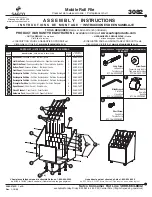
ORTHORALIX 9200
Service Manual
B-3
Gendex Dental Systems 4519-190-71193-7
In the case of other less resistant wall types (hollow bricks, wood)
which, however, can bear the specified load without evident de-
formation, we recommend using the “through the wall” method
of attachment of the fig. below, which uses a front steel reinforce-
ment plate (2 mm thick) and a steel counter plate (2 mm thick) of
a larger size than the column wall attachment, fixed with screws
or stay bolts, ensuring a tightening force on the bolts of 10 N/m.
Doubling the surface of the steel plates with respect to the size
of the column wall attachment, will halve the static load applied
to the wall.
Wall
Steel counter plate
Column
Anterior steel plate
Wall
Steel counter plate
Column
In the case of other very weak walls (wood, etc.) a steel construc-
tion is needed.
Irregularities in floor levels, within a 2mm/m tolerance, can be
compensated at installation time by means of levelling shims
supplied with the system.
For the preparation of the fixing holes in the wall please refer
to B-28.
(03.0)E
B.4.4
Electrical pre-installation
The Orthoralix requires a fixed electrical installation.
The mains cable required is two poles with ground (not sup-
plied).
The mains cable inlet is at the rear of the column, and is provided
with cable retainer.
Therefore a suitable outlet shall be provided on the wall behind
the column, from where the mains supply cable has to be de-
rived.
The remote control box is connected to the Z-carriage by a 20
m cable.
The cable inlet is at the rear of the column.
The mains supply cable has to be connected to the mains circuit
connection points, accessible at the front of the column.
Total mains cable resistance must take the specified mains
resistance limits into account (see table below)
VOLTAGE (VAC)
MAX. LINE RESISTENCE (OHM)
115
0.2 MAX
230
1.0 MAX
250
1.0 MAX
For calculation purposes a list of different wire sizes with related
resistances is given:
SIZE
RESISTANCE / METER
AWG16 (1.35 mm²)
0.03 (2 x 0.015) Ohm/m
AWG14 (2.11 mm²)
0.0188 (2 x 0.0094) Ohm/m
B.4.5
X-Ray protection
The machine is intended for (indoor) dental practice without
special X-ray protection in walls, floors and ceilings.
X-ray protection comes from the distance to be kept from the
unit, proper X-ray beam collimation and inherent shielding
implemented in the machine.
Primary X-ray beams are shielded by a lead plate, located in the
rear of the cassette unit (thickness:1.5 mm in Pan and Transcan,
1 mm in Ceph mode).
In the DDE versions, the X-ray beams are shielded by the sensor
assembly, introducing a filtration equivalent to 1.5 mm of lead.
Printed on: 20 Apr 2012, 04:59:40 pm; Printed by: UWE.ZELLER
















































